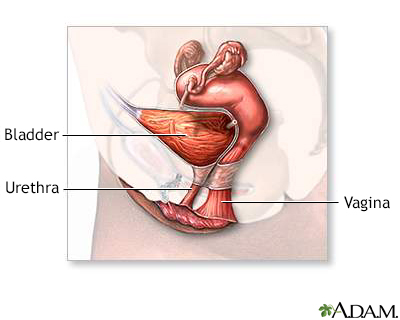Vaginismus
Sexual dysfunction - vaginismus
Vaginismus is a spasm of the muscles surrounding the vagina that occurs against your will. The spasm makes the vagina very narrow and can prevent sexual activity and medical exams.

External structures of the female reproductive anatomy include the labium minora and majora, the vagina and the clitoris. Internal structures include the uterus, ovaries, and cervix.

The female reproductive and urinary systems.
Causes
Vaginismus is a sexual problem. It has several possible causes, including:
- Past sexual trauma or abuse
- Mental health factors
- A response that develops due to physical pain
- Intercourse
Sometimes no cause can be found.
Vaginismus is an uncommon condition.
Symptoms
The main symptoms are:
- Difficult or painful vaginal penetration during sex. Vaginal penetration may not be possible.
- Vaginal pain during sexual intercourse or a pelvic exam.
Women with vaginismus often become anxious about sexual intercourse. This does not mean they cannot become sexually aroused. Many women with this problem can have orgasms when the clitoris is stimulated.
Exams and Tests
A pelvic exam can confirm the diagnosis. A medical history and complete physical exam are needed to look for other causes of pain with sexual intercourse (dyspareunia).
Treatment
A health care team made up of a gynecologist, physical therapist, and sexual counselor can help with treatment.
Treatment involves a combination of physical therapy, education, counseling, and exercises such as pelvic floor muscle contraction and relaxation (Kegel exercises).
Your provider may recommend injection of medicines to help relax the vaginal muscles.
Vaginal dilation exercises using plastic dilators are recommended. This method helps to make the person less sensitive to vaginal penetration. These exercises should be done under the direction of a sex therapist, physical therapist, or other health care provider. Therapy should involve the partner and can slowly lead to more intimate contact. Intercourse may ultimately be possible.
You will get information from your provider. Topics may include:
- Sexual anatomy
- Sexual response cycle
- Common myths about sex
Outlook (Prognosis)
Women who are treated by a sex therapy specialist can very often overcome this problem.
References
Cowley DS, Burke A, Lentz GM. Additional considerations in gynecologic care. In: Gershenson DM, Lentz GM, Valea FA, Lobo RA, eds. Comprehensive Gynecology. 8th ed. Philadelphia, PA: Elsevier; 2022:chap 9.
Kocjancic E, Iacovelli V, Acar O. Sexual function and dysfunction in the female. Partin AW, Dmochowski RR, Kavoussi LR, Peters CA, eds. Campbell-Walsh-Wein Urology. 12th ed. Philadelphia, PA: Elsevier; 2021:chap 74.
Rowen TS, Simon JA. Sexual dysfunction in the female. In: Robertson RP ed. DeGroot's Endocrinology. 8th ed. Philadelphia, PA: Elsevier; 2023:chap 128.
Version Info
Last reviewed on: 4/16/2024
Reviewed by: John D. Jacobson, MD, Professor Emeritus, Department of Obstetrics and Gynecology, Loma Linda University School of Medicine, Loma Linda, CA. Also reviewed by David C. Dugdale, MD, Medical Director, Brenda Conaway, Editorial Director, and the A.D.A.M. Editorial team.
